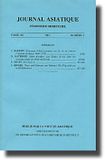Journal Asiatique 2011 - Vol. 299,1
Journal Asiatique
Journal asiatique : ou recueil de mémoires d'extraits et de notices relatifs à l'histoire, à la philosophie, aux sciences, à la littérature et aux langues des peuples orientaux / publ. par la Société Asiatique. - Vol. 299,1 (2011). - Paris : Société Asiatique (distr.: Louvain : Peeters), 2011.
ISSN 0021-762X (Printausgabe)
ISSN 1783-1504 (Online-Version)
URL: Peeters
Abstract: One of the most common images used to describe the Buddha is that he is the supreme physician, the great healer who cures the ultimate disease, which is transmigratory existence. The image of a great religious leader as a healer was not uniquely Buddhist. But it is also not unproblematic. Attitudes towards doctors varied greatly in early India and were often strikingly negative. This paper explores the range of attitudes towards physicians in story literature and philosophical texts.
Abstract: This paper traces the practice of transferring inauspiciousness in contemporary Hindu ethnography to the 'Great Gifts' (mahādānas) of Medieval 'Vedic-Hinduism'. The latter appear to have developed within an astrologically oriented ritual culture, in which sins became causally linked to the distribution of personal misfortune through the mediation of portents, or natural signs originating in the earth, atmosphere, or heavens. The ritual form of the mahādānas in late Vedic and Purāṇic texts expresses the 'practical' counterpart of this astrological theory of sin, insofar as it combines the model of 'atonement through gifting' with 'appeasement through consecration'. The formation of this ritual complex also appears to have resulted in theoretical tensions that can be seen in modern ethnography.
Abstract: Cet article présente l’étude de la plus ancienne inscription de l’ancien Pāṇḍuraṅga, dans l’extrême Sud du Campā, datée de 778 de notre ère. La stèle qui porte cette inscription a été trouvée en 2006 sur le site de Hoà Lai (province de Ninh Thuân, Vietnam), et donne pour la première fois un argument épigraphique pour dater l’architecture de ce temple. La présentation de l’inscription donne également l’occasion de reconsidérer l’histoire dynastique, l’histoire des cultes religieux ainsi que les pratiques épigraphiques au Pāṇḍuraṅga à cette haute époque et durant les siècles suivants. Les aspects saillants sont une idéologie de succession matrilinéaire du pouvoir; des traditions politiques et cultuelles héritées du Zhenla et du Funan, ainsi qu’une condition d’indépendance effective du Pāṇḍuraṅga par rapport aux régions plus septentrionales du Campā; la domination du śivaïsme; une tradition spécifiquement locale de production d’inscriptions, dont Satyavarman aura été l’initiateur, et qui emploie pendant les siècles initiaux presqu’exclusivement la langue sanskrite.
Ähnlich
- Journal Asiatique 2011 - Vol. 299,2
- Acta Orientalia 2011 - Vol. 64
- Journal Asiatique 2010 - Vol. 298,2
- JAS 2011 - Vol. 70,1
- Journal Asiatique 2010 - Vol. 298,1
- Tohogaku 2010 - 119
- Journal of the Royal Asiatic Society 2010 - 20,1
- Scripta 2009 - 1
- Rivista degli Studi Orientali 2007 - Vol. 80
- Asiatische Studien 63,1 (2009)

